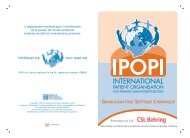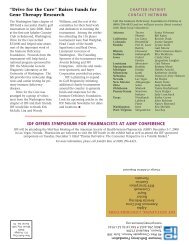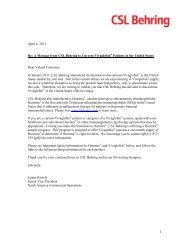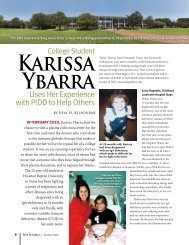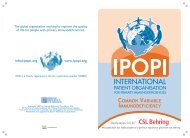IDF Patient & Family Handbook for Primary Immunodeficiency ... - IDFA
IDF Patient & Family Handbook for Primary Immunodeficiency ... - IDFA
IDF Patient & Family Handbook for Primary Immunodeficiency ... - IDFA
You also want an ePaper? Increase the reach of your titles
YUMPU automatically turns print PDFs into web optimized ePapers that Google loves.
136 Glossary<br />
Glossary<br />
Lymph nodes: Small bean-sized organs of the<br />
immune system, distributed widely throughout<br />
the body. Each lymph node contains a variety of<br />
specialized compartments that house B-lymphocytes,<br />
T-lymphocytes, and macrophages. Lymph nodes unite<br />
in one location the several factors needed to produce<br />
an immune response.<br />
Lymphocytes: Small white cells, normally present<br />
in the blood and in lymphoid tissue, that bear the<br />
major responsibility <strong>for</strong> carrying out the functions of<br />
the immune system. There are two major <strong>for</strong>ms of<br />
lymphocytes, B-lymphocytes, and T-lymphocytes,<br />
which have distinct but related functions in generating<br />
an immune response.<br />
Lymphoma: Type of cancer of the lymphocytes of the<br />
immune system.<br />
Macrophages: A phagocytic tissue cell of the immune<br />
system that functions in the destruction of <strong>for</strong>eign<br />
antigens (as bacteria and viruses), and serves as an<br />
antigen-presenting cell.<br />
Major histocompatibility complex: A series<br />
of genes on chromosome 6 that direct the synthesis<br />
of the chemicals on the surface of many cells of the<br />
body, including the cells of the immune system, which<br />
are relatively unique to each individual and provide our<br />
tissue type.<br />
Malignancy: Cancer.<br />
Metabolism: A general term which summarizes the<br />
chemical changes within a single cell, and the body<br />
as a whole, which results in either the building up or<br />
breaking down of living material.<br />
Microorganisms: Minute living organisms, usually<br />
one-cell organisms, which include bacteria, protozoa,<br />
and fungi.<br />
Molecules: The smallest unit of matter of an element<br />
or compound.<br />
Monocyte: Phagocytic cell found in the blood that<br />
acts as a scavenger, capable of destroying invading<br />
bacteria or other <strong>for</strong>eign material; these cells develop<br />
into macrophages in tissues.<br />
Monokines: Chemical messengers produced and<br />
secreted by monocytes and macrophages.<br />
Mucosal surfaces: Surfaces that come in close<br />
contact with the environment, such as the mucus<br />
membranes of the mouth, nose, gastrointestinal tract,<br />
eyes, etc; IgA antibodies protect these surfaces, or<br />
mucus membranes, from infection.<br />
Neurology: A branch of medicine concerned<br />
especially with the structure, functions, and diseases<br />
of the nervous system.<br />
Neutropenia: A lower than normal amount of<br />
neutrophils in the blood.<br />
Neutrophils: A type of granulocyte, found in the<br />
blood and tissues that can ingest microorganisms.<br />
Nystagmus: Involuntary usually rapid movement<br />
of the eyeballs.<br />
Opportunistic infection: An infection that<br />
occurs only under certain conditions, such as in<br />
immunodeficient individuals.<br />
Organism: An individual living thing.<br />
Osteomyelitis: Infection of the bone.<br />
Parasite: A plant or animal that lives, grows, and feeds<br />
on or within another living organism.<br />
Parathyroid gland: Small glands found in the neck<br />
near the thyroid that control the normal metabolism<br />
and blood levels of calcium.<br />
Petechiae: Pinhead-sized red spots resulting from<br />
bleeding into the skin.<br />
Phagocyte: A general class of white blood cells that<br />
ingest microbes and other cells and <strong>for</strong>eign particles;<br />
monocytes, macrophages, and neutrophils are types<br />
of phagocytes.<br />
Plasma cells: Antibody-producing cells descended<br />
from B-lymphocytes.<br />
Plasmapheresis: A process in which blood taken<br />
from a patient is treated to extract the cells and<br />
corpuscles, which are then added to another fluid and<br />
returned to the patient’s body.<br />
Platelets: Smallest and most fragile of the blood cells;<br />
primary function is associated with the process of<br />
blood clotting.<br />
Polymorphism: The quality or state of existing in or<br />
assuming different <strong>for</strong>ms.<br />
Polysaccharides: Complex sugars.<br />
<strong>Primary</strong> immunodeficiency: <strong>Immunodeficiency</strong><br />
that is intrinsic to the cells and tissues of the immune<br />
system, not due to another illness, medication or<br />
outside agent damaging the immune system.<br />
Prophylactic: Medical therapy initiated to prevent<br />
or guard against disease or infection.<br />
Protein: A class of chemicals found in the body<br />
made up of chains of amino acids (building blocks);<br />
immunoglobulins (antibodies) are proteins.<br />
Recurrent infections: Infections, such<br />
as otitis, sinusitis, pneumonia, deep-seated<br />
abscess, osteomyelitis, bacteremia or meningitis<br />
that occur repeatedly.<br />
Secondary immunodeficiency:<br />
<strong>Immunodeficiency</strong> due to another illness or agent,<br />
such as human immunodeficiency virus (HIV),<br />
cancer, or chemotherapy.








